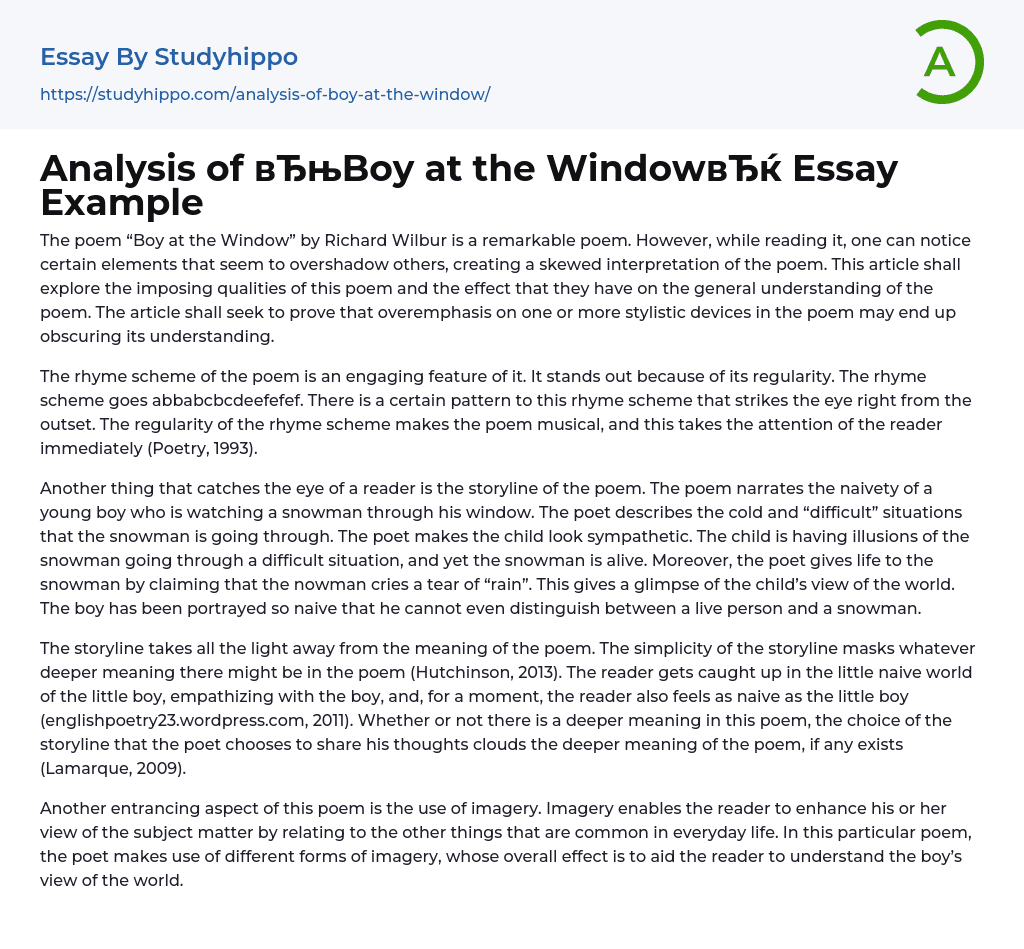The poem “Boy at the Window” by Richard Wilbur is a remarkable poem. However, while reading it, one can notice certain elements that seem to overshadow others, creating a skewed interpretation of the poem. This article shall explore the imposing qualities of this poem and the effect that they have on the general understanding of the poem. The article shall seek to prove that overemphasis on one or more stylistic devices in the poem may end up obscuring its understanding.
The rhyme scheme of the poem is an engaging feature of it. It stands out because of its regularity. The rhyme scheme goes abbabcbcdeefefef. There is a certain pattern to this rhyme scheme that strikes the eye right from the outset. The regularity of the rhyme scheme makes the poem musical, and this takes the att
...ention of the reader immediately (Poetry, 1993).
Another thing that catches the eye of a reader is the storyline of the poem. The poem narrates the naivety of a young boy who is watching a snowman through his window. The poet describes the cold and “difficult” situations that the snowman is going through. The poet makes the child look sympathetic. The child is having illusions of the snowman going through a difficult situation, and yet the snowman is alive. Moreover, the poet gives life to the snowman by claiming that the nowman cries a tear of “rain”. This gives a glimpse of the child’s view of the world. The boy has been portrayed so naive that he cannot even distinguish between a live person and a snowman.
The storyline takes all the light away from the meaning of the poem.
The simplicity of the storyline masks whatever deeper meaning there might be in the poem (Hutchinson, 2013). The reader gets caught up in the little naive world of the little boy, empathizing with the boy, and, for a moment, the reader also feels as naive as the little boy (englishpoetry23.wordpress.com, 2011). Whether or not there is a deeper meaning in this poem, the choice of the storyline that the poet chooses to share his thoughts clouds the deeper meaning of the poem, if any exists (Lamarque, 2009).
Another entrancing aspect of this poem is the use of imagery. Imagery enables the reader to enhance his or her view of the subject matter by relating to the other things that are common in everyday life. In this particular poem, the poet makes use of different forms of imagery, whose overall effect is to aid the reader to understand the boy’s view of the world.
The poet uses simile as he describes the empty stare that the snowman gives to the boy:
“…such a God – forsakken stare
As outcast Adam gave to paradise” (lines 8, 9) (Wilbur, 1952)
This simile enables the reader to understand the depth of the emptiness of the ‘stare’ which the snowman gives the boy. Ordinarily, any experienced human being would interpret that kind of blank stare to be an image of a person or a curving. However, the child in his naivety and innocence thinks that the snowman is alive and is actually suffering the chill of dusk.
The poet also makes use of personification. The poet gives the snowman life so as to portray the child’s view of it. For instance, the
poet says that the snowman is moved to see the youngster cry. This is probably what the child thinks; he thinks that the snowman feels moved because of his sympathy. Personification also simplifies the understanding of the poem (Keenleyside, 2009).
The use of imagery enhances the understanding of the poem, because it eliminates some abstraction from the poem and brings it closer. However, the rhyme scheme and the storyline of the poem hijack the attention of the poem, making the reader focus on certain aspects of the poem more than on others. This highlights the importance of making a poem balanced, so that the reader remains interested in the poem as he or she reads out its content.
- Boo Radley essays
- Genesis essays
- Richard iii essays
- Alice in Wonderland essays
- On the road essays
- Ozymandias essays
- The Nightingale essays
- Holden Caulfield essays
- Animal Farm essays
- 1984 essays
- A Hanging essays
- Shooting An Elephant essays
- A Tale Of Two Cities essays
- Adventures Of Huckleberry Finn essays
- Arthur Conan Doyle essays
- Brave New World essays
- Characters In Hamlet essays
- Characters In Romeo And Juliet essays
- Desdemona essays
- Diary Of A Wimpy Kid essays
- First-Person Narrative essays
- Frankenstein essays
- Heart Of Darkness essays
- Jane Eyre essays
- Jay Gatsby essays
- King Duncan essays
- Librarian essays
- Little Red Riding Hood essays
- Lord Of The Flies essays
- Silas Marner essays
- The Cask Of Amontillado essays
- The Catcher In The Rye essays
- The Crucible essays
- The Handmaid's Tale essays
- The Reader essays
- Virgil essays
- Wuthering Heights essays
- Candide essays
- Castle essays
- J. D. Salinger essays
- Ulysses essays
- Ethan Frome essays
- In Cold Blood essays
- Outliers essays
- Tuesdays With Morrie essays
- The Art of War essays
- Wife of Bath essays
- Huckleberry Finn essays
- The Lady With The Dog essays
- Great Expectations essays




